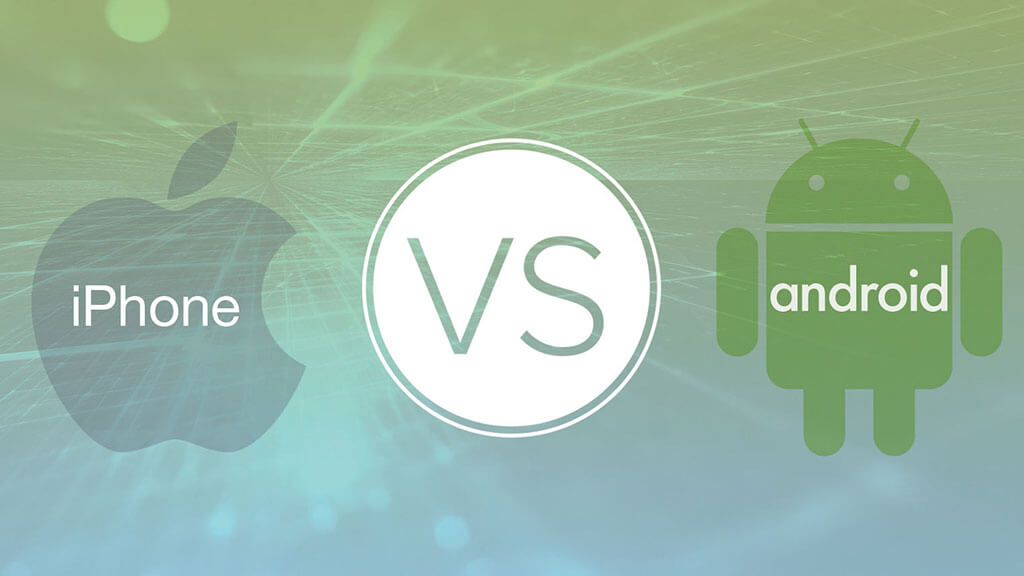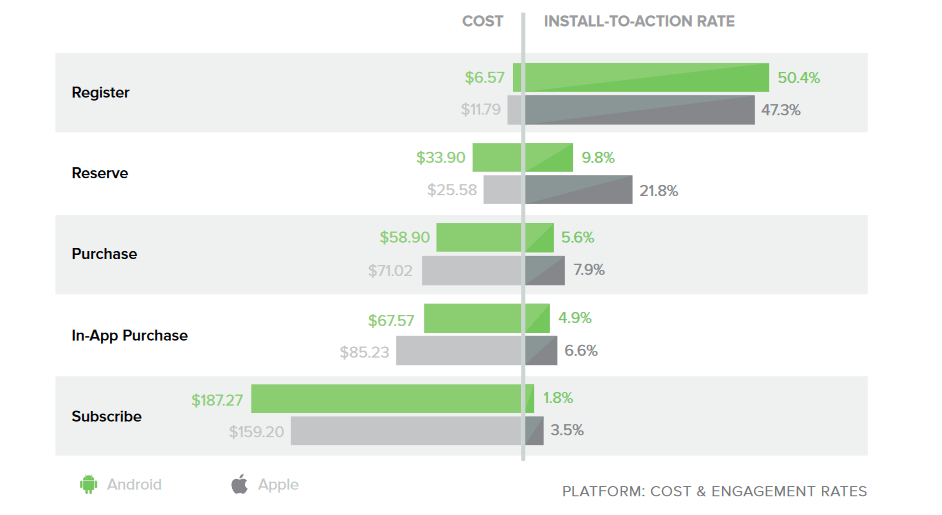Don't miss the chance to work with top 1% of developers.
Sign Up Now and Get FREE CTO-level Consultation.
Confused about your business model?
Request a FREE Business Plan.
iOS vs Android User Experience
Table of contents

Six things App Store and Google Play Users Do Differently
All thanks to the exponential technological growth, the small gadgets(smartphones) we carry in our pockets wield a lot more power than the computers NASA used for its moon missions.
Smartphones are more like extensions of us humans and send out messages about who we really are to the ones around us.
Our somewhat small nuclear devices, that’s how powerful they are, are an integral part of our lifestyle and they have made us even more mobile than we ever were.
Let’s take in consideration some research by US Mobile App Reports from the house of ComScore, which states that –
-
We almost spend 50% of our digital time using smartphone applications. In the war between times spend on Mobile Web and Mobile apps the latter is a clear winner.
-
We are most likely to open only 20 or lesser applications in our phones monthly, also we position them as such that are accessible with ease.
Interestingly, the smartphone or mobile platform we choose speaks volumes about our habits, behavior and what’s our personality like.
Although all the platforms, be it be, Google’s Android or Apple’s iOS have their owns perks and hardships for the users. In the middle of this who’s the best game, users feel a huge difference between Android and iOS user experience. Let’s outline it of you, here’s how people feel both the platforms are different and why.
Gadget Specific Differences
iPhone and Android both types of smartphones come with their own set of capabilities which result in a huge difference in terms of user experience. For instance, Apple has a strict-solid set of regulations when it comes to uploading apps on the app store, whereas Android developers can easily make and submit applications to their respective app store with a lot more ease and quickness – thereby resulting a huge number of apps in the Google play store as compared to the ones in iOS one.
However, the large number of apps in the Android store are not completely of higher quality or for that matter don’t make it a better option. As to get uploaded in the Apple app store an iOS app not only takes a longer time to develop but it also passes a much stricter verification process, iOS apps are more likely to be stable, easy-to-use and secure too, on the contrary to the end-number of cumbersome applications available in the Google App Store.

Although Android devices don’t make a hole in the pocket, unlike their IOS counterparts, the latter has a huge loyal customer base. When it comes to global share iPhone just owns 11% of its, but it still reigns as one of the top industry players when it comes to revenue generation.
Android users boast the extensive customization their devices offer, whereas Apple users are happy with the comfortable user interfaces their devices have.
User Demographics
User demographics, personal characteristics, and location extensively dominate the choice of our new smartphone.
The developed countries like the United Kingdom, the United States, European nations, etc. have the highest number of iPhone users. These iOS device owners have high wages and high education levels too.
Young Females with highly educated backgrounds make the majority of iOS device owners.
Whereas Android users on an average hold a diploma degree and even earn significantly lower than iOS consumers, in general. This indicates that they mostly live in developing newly developed nations. They are also more likely to have a lower social status too.
Response to Push Notifications
This might sound a very minor issue, but responsiveness to push notifications can be a huge point of discussion between iOS and Android users.
Going by research we have found that around 3.5% of Android users will say yes to opening their push notifications in comparison to only 1.8% of Apple users who opt for the same. This can be because of the user interface design principles.
In Android devices, the users need to either swipe the notification or make a gesture in order to mark read the notification- else it will be stuck in the phone’s lock screen. Therefore, most of the users check-out their lock screen in order to check their notifications.
In iPhones, the push notifications disappear from the lock screen sometime after popping up- thus notably lessening the numbers of users who open these notifications. However, iOS users generally take not more than 7 minutes to open notifications in their phones. This is a lot quicker than Android users, who usually take around 48 minutes to respond to any notifications on their device. This shows that Apple users have a high level of interaction levels in comparison to Android users.
Gaming Experience
Gaming experience is a huge influence when it comes to defining the choice of a smartphone by anyone(especially the youngsters of today). It’s a must have a pointer while discussing anything about user experience in today’s modern gadget culture. Thus, users give gaming experience a great hand when it comes to determining their next smartphone.
The iOS App Store has less but significantly a lot more enjoyable gaming experience to offer. Most top-notch game developers, however, make games for both types of devices-though there are few exciting games that cater to one of the app stores only.
If researchers are believed, they found that Android users are harsher than iOS phone users when it comes to scrutinizing games. This shows the contentedness iPhone users have when it comes to gaming experience. Android device users come out as clear winners in terms of the number and hours put-in to play complex games, as these users can make use of the huge memory their devices offer and they can also enhance their present ROM all by themselves. This open source feature helps Android outperform Apple devices when it comes to heavy memory capacity games.
In-app Engagement and Retention
App engagement plays a vital role when it comes to understanding the UI experience of any platform. How users engage across different platforms give us a much-needed insight and give us a sure-shot way to understand the inclination of the users towards a certain type of smartphone. It is a notable fact that the mindset of the users is defined by the way a particular application runs in a specific platform.

As per a recent Android & iOS user statistics, iOS users invest a lot more time interacting with any given application. iOS users on spend an average of nine hours more per month on their apps than the ones using Android phones. Thus proving that an average iOS user is a power-consumer of smartphone gadgets, all thanks to enhanced engagement levels with the help of some creative content.
Although Android gadgets let their users engage more significantly with any given application, iPhones win the game when it comes to post-installation experiences and interactions. On average, iOS users are a lot more content with the smartphone they are using and they are more likely to retain the gadget for a lot longer. Loyalty among its users plays the key to iPhone’s continuously increasing revenue even with a price rise every now and then.
Satisfaction and Loyalty
Customer satisfaction marks an important pointer when it comes to user loyalty towards a specific platform. Loyal and satisfied customers are equal to a commitment for long-term towards specific types of devices. Most of the iOS device owners have great regard for their devices; they are usually more satisfied with the gadgets than their Android counterparts.
Around 62% (precisely two-thirds) of iOS users are highly contented with their smartphone, and almost 80% of them have owned an iOS device before too.
With a satisfaction rate of 48% of Android users also sustains a decent percentage.
iOS devices also have an upper hand in terms of highly enhanced marketing approach which makes a lot more eyes turn towards than any Android device. A large number of Android customers love the openness their gadgets offer and even the extensive personalization they offer. iOS users on the other hand like the consistent user interface experience and the familiar interface the devices offer.
Summary
iOS and Android may share a lot of similar functionalities, there is a significant difference when it comes to user experience. This leads to a bag full of differences in terms of customer behavior. We hope the above comparisons help you make the right choice
Rate this article!
(12 ratings, average: 3.08 out of 5)
Join 60,000+ Subscribers
Get the weekly updates on the newest brand stories, business models and technology right in your inbox.

Experiencing the journey with excitement, tackling the obstacles with the zeal to disrupt the vision of the world through her words is what defines the attitude of Vaishali Sonik. Vaishali a.k.a. Maggie took a turn from her Masters Journey in E.C.E to become an Internet influencer. Since 2014, she has been blending & molding her words to express the knowledge she has alongside learning herself at every step. She describes her profession as an Online Content Strategist & Writer, a way to learn something new at every step.

Telemedicine 2.0 - A Comprehensive Guide On What Healthcare Providers Need To Know?
Discover how the latest advancements like Artificial Intelligence in telemedicine are reshaping patient care. This comprehensive resource offers insights into the key trends and innovations driving this shift, providing valuable knowledge for healthcare professionals looking to stay ahead.
Download Now!Don't Know Much
About Technology?
Let our experts help you decide the right tech stack for your idea.


















